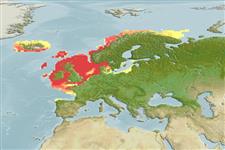Preferred temperature (Ref.
115969): 7.1 - 12.5, mean 9.9 (based on 1310 cells).
Phylogenetic diversity index (Ref.
82804): PD
50 = 0.5625 [Uniqueness, from 0.5 = low to 2.0 = high].
Bayesian length-weight: a=0.00759 (0.00603 - 0.00954), b=3.09 (3.02 - 3.16), in cm Total Length, based on LWR estimates for this species (Ref.
93245).
Trophic level (Ref.
69278): 3.2 ±0.33 se; based on food items.
Resilience (Ref.
120179): Medium, minimum population doubling time 1.4 - 4.4 years (K=0.08-0.42; tm=3-6; tmax=23).
Prior r = 0.71, 95% CL = 0.47 - 1.07, Based on 1 full stock assessment.
Fishing Vulnerability (Ref.
59153): Moderate to high vulnerability (51 of 100).
Climate Vulnerability (Ref.
125649): Low to moderate vulnerability (29 of 100).
